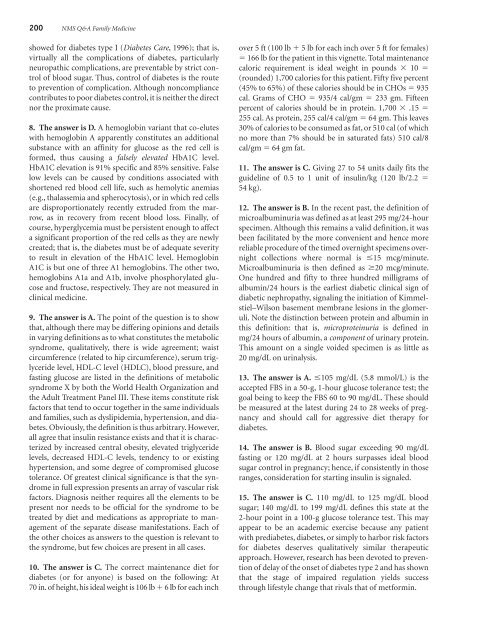NMS Q&A Family Medicine
NMS Q&A Family Medicine
NMS Q&A Family Medicine
- No tags were found...
Create successful ePaper yourself
Turn your PDF publications into a flip-book with our unique Google optimized e-Paper software.
200 <strong>NMS</strong> Q&A <strong>Family</strong> <strong>Medicine</strong>showed for diabetes type I ( Diabetes Care , 1996); that is,virtually all the complications of diabetes, particularlyneuropathic complications, are preventable by strict controlof blood sugar. Thus, control of diabetes is the routeto prevention of complication. Although noncompliancecontributes to poor diabetes control, it is neither the directnor the proximate cause.8. The answer is D. A hemoglobin variant that co-eluteswith hemoglobin A apparently constitutes an additionalsubstance with an affinity for glucose as the red cell isformed, thus causing a falsely elevated HbA1C level.HbA1C elevation is 91% specific and 85% sensitive. Falselow levels can be caused by conditions associated withshortened red blood cell life, such as hemolytic anemias(e.g., thalassemia and spherocytosis), or in which red cellsare disproportionately recently extruded from the marrow,as in recovery from recent blood loss. Finally, ofcourse, hyperglycemia must be persistent enough to affecta significant proportion of the red cells as they are newlycreated; that is, the diabetes must be of adequate severityto result in elevation of the HbA1C level. HemoglobinA1C is but one of three A1 hemoglobins. The other two,hemoglobins A1a and A1b, involve phosphorylated glucoseand fructose, respectively. They are not measured inclinical medicine.9. The answer is A. The point of the question is to showthat, although there may be differing opinions and detailsin varying definitions as to what constitutes the metabolicsyndrome, qualitatively, there is wide agreement; waistcircumference (related to hip circumference), serum triglyceridelevel, HDL-C level (HDLC), blood pressure, andfasting glucose are listed in the definitions of metabolicsyndrome X by both the World Health Organization andthe Adult Treatment Panel III. These items constitute riskfactors that tend to occur together in the same individualsand families, such as dyslipidemia, hypertension, and diabetes.Obviously, the definition is thus arbitrary. However,all agree that insulin resistance exists and that it is characterizedby increased central obesity, elevated triglyceridelevels, decreased HDL-C levels, tendency to or existinghypertension, and some degree of compromised glucosetolerance. Of greatest clinical significance is that the syndromein full expression presents an array of vascular riskfactors. Diagnosis neither requires all the elements to bepresent nor needs to be official for the syndrome to betreated by diet and medications as appropriate to managementof the separate disease manifestations. Each ofthe other choices as answers to the question is relevant tothe syndrome, but few choices are present in all cases.10. The answer is C. The correct maintenance diet fordiabetes (or for anyone) is based on the following: At70 in. of height, his ideal weight is 106 lb 6 lb for each inchover 5 ft (100 lb 5 lb for each inch over 5 ft for females) 166 lb for the patient in this vignette. Total maintenancecaloric requirement is ideal weight in pounds 10 (rounded) 1,700 calories for this patient. Fifty five percent(45% to 65%) of these calories should be in CHOs 935cal. Grams of CHO 935/4 cal/gm 233 gm. Fifteenpercent of calories should be in protein. 1,700 .15 255 cal. As protein, 255 cal/4 cal/gm 64 gm. This leaves30% of calories to be consumed as fat, or 510 cal (of whichno more than 7% should be in saturated fats) 510 cal/8cal/gm 64 gm fat.11. The answer is C. Giving 27 to 54 units daily fits theguideline of 0.5 to 1 unit of insulin/kg (120 lb/2.2 54 kg).12. The answer is B. In the recent past, the definition ofmicroalbuminuria was defined as at least 295 mg/24-hourspecimen. Although this remains a valid definition, it wasbeen facilitated by the more convenient and hence morereliable procedure of the timed overnight specimens overnightcollections where normal is 15 mcg/minute.Microalbuminuria is then defined as 20 mcg/minute.One hundred and fifty to three hundred milligrams ofalbumin/24 hours is the earliest diabetic clinical sign ofdiabetic nephropathy, signaling the initiation of Kimmelstiel–Wilsonbasement membrane lesions in the glomeruli.Note the distinction between protein and albumin inthis definition: that is, microproteinuria is defined inmg/24 hours of albumin, a component of urinary protein.This amount on a single voided specimen is as little as20 mg/dL on urinalysis.13. The answer is A. 105 mg/dL (5.8 mmol/L) is theaccepted FBS in a 50-g, 1-hour glucose tolerance test; thegoal being to keep the FBS 60 to 90 mg/dL. These shouldbe measured at the latest during 24 to 28 weeks of pregnancyand should call for aggressive diet therapy fordiabetes.14. The answer is B. Blood sugar exceeding 90 mg/dLfasting or 120 mg/dL at 2 hours surpasses ideal bloodsugar control in pregnancy; hence, if consistently in thoseranges, consideration for starting insulin is signaled.15. The answer is C. 110 mg/dL to 125 mg/dL bloodsugar; 140 mg/dL to 199 mg/dL defines this state at the2-hour point in a 100-g glucose tolerance test. This mayappear to be an academic exercise because any patientwith prediabetes, diabetes, or simply to harbor risk factorsfor diabetes deserves qualitatively similar therapeuticapproach. However, research has been devoted to preventionof delay of the onset of diabetes type 2 and has shownthat the stage of impaired regulation yields successthrough lifestyle change that rivals that of metformin.
















